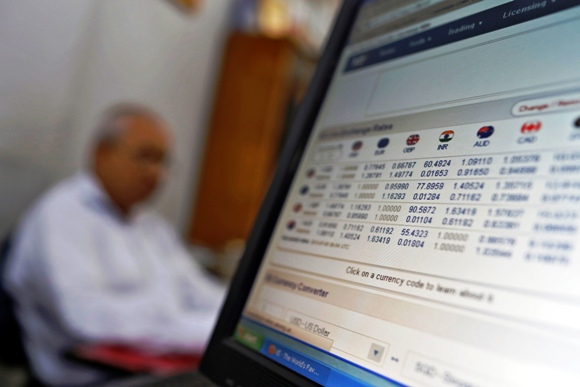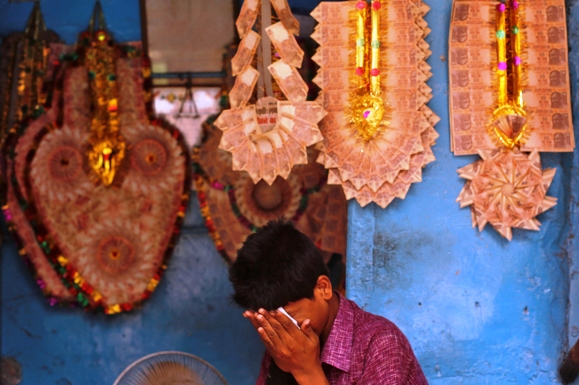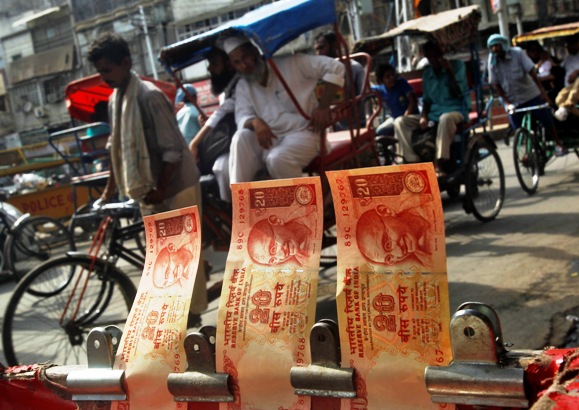Photographs: Vivek Prakash/Reuters Rafael Nam Himank Sharma and Carolyn Cohn in Mumbai/London
As India's rupee hits record lows, some investors see it headed towards the mid-60s against the dollar, a reflection of weak economic fundamentals and expectations the government will struggle to implement meaningful measures to reverse capital outflows.
Domestic forwards markets, which reflect market expectations, see the rupee trading at around 65 to the dollar in a year, while offshore forward markets see it at 66.
Pessimism remains even as the government is widely expected to announce steps soon to encourage more foreign inflows, including potentially raising debt abroad, after the Reserve Bank of India's steps to drain cash from the financial system failed to prop up the currency.
. . .
Why rupee will continue to remain weak
Image: A man sits next to a computer screen showing the Indian rupee currency rates inside a private money exchange office in New Delhi.Photographs: Adnan Abidi/Reuters
"We're very worried about the situation in India," said Walter Rossini, who manages the 130 million euro ($173 million) Gestielle Obiettivo India Fund in Milan.
"There's no fast fix to this situation. Probably we will see a turnaround of the economic cycle in a few quarters but rupee volatility will stay for longer.
"I don't see a strong case for it coming back to the average level of last year," he said.
The rupee hit a record low of 61.80 on Tuesday, marking a 10 per cent fall so far this year -- the worst performer in emerging Asia in currencies tracked by Reuters.
Over two years, it is down 26 per cent.
A record high current account deficit at 4.8 percent of gross domestic product has made India particularly vulnerable in an emerging markets sell-off sparked by anticipation the US Federal Reserve will soon wind down its ultra-loose monetary policy.
. . .
Why rupee will continue to remain weak
Image: A man walks past a board advertising US dollars at a money exchange shop in Colombo.Photographs: Dinuka Liyanawatte/Reuters
Plenty of challenges
One of the first tasks confronting former International Monetary Fund chief economist Raghuram Rajan, who takes over at the helm of the central bank on September 5, will be whether to continue the RBI's liquidity tightening steps, which have failed to stem the decline but have pushed up short-term borrowing costs, adding to pressure on the already cooling economy.
In the meantime, New Delhi is widely expected to announce measures such as raising money from Indians abroad, but emergency steps are likely to prove insufficient unless India tackles fundamental and years-old problems that deter more robust inflows from corporations and other long-term investors.
. . .
Why rupee will continue to remain weak
Image: A vendor wipes his face at a shop selling garlands made of Indian currency notes in the old quarters of Delhi.Photographs: Adnan Abidi/Reuters
Those problems include heavy dependence on oil and gold imports, high inflation and political and bureaucratic gridlock that deter capital investment.
The task facing Rajan and Finance Minister P Chidambaram is complicated by the ruling coalition's weakness ahead of general elections by next May, in a global investor environment that no longer favours emerging markets.
"At the end of the day, it's a political issue that's really been holding back India to a large extent. Even with the right policies, if minority parties don't support reforms, it's going to make it very difficult for them to move forward," said Rajiv Biswas, economist at IHS Global Insights in Singapore.
In his current role as chief economic adviser, Rajan has suggested raising money from Indians abroad or easing overseas borrowing norms -- steps that would be likely to boost the rupee and bring down bond yields, at least in the near-term.
. . .
Why rupee will continue to remain weak
Image: Cycle rickshaws move past a display of Indian rupees at a roadside currency exchange stall in the old quarters of Delhi.Photographs: Anindito Mukherjee/Reuters
Raising interest rates, one of the traditional tools for defending a currency, might attract inflows but risk eroding confidence in an economy growing at a decade low of 5 per cent.
Higher interest rates could also choke off inflows into equity markets, which have been a relative bright spot.
Despite foreign exits over the past two months, Indian stocks are sitting on net inflows of $12.7 billion in 2013.
"The underlying situation is deteriorating.
"The economy is struggling to grow, there is a fiscal and current account deficits, and we are going into an electoral period," said Philip Poole, global head of macro investment strategy at HSBC Asset Management in London.
"From a fundamental point of view, the currency looks cheap, but the flows in the short term are a concern. There needs to be some consistent policy coming from the government and the central bank." ($1 = 0.7508 euros)







article